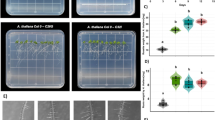Abstract
Two types of Barbarea vulgaris var. arcuata, the G-type and the P-type, differed in resistance to larvae of the diamondback moth (DBM) Plutella xylostella. Rosette plants of the G-type were fully resistant to the DBM when grown in a greenhouse or collected in the summer season, but leaves collected during the late fall were less resistant, as previously found for flea beetle resistance. The P-type was always susceptible. Extracts of resistant leaflets inhibited larval growth in a bioassay, and a growth-inhibiting fraction was isolated by activity-guided fractionation. A triterpenoid saponin (1) was isolated from this fraction and identified as 3-O-β-cellobiosyloleanolic acid from spectroscopic data and analysis of hydrolysis products. The decrease in resistance of the G-type in the fall was correlated with a decrease in the level of 1, from 0.6–0.9 to <0.2 μmol/g dry wt. Compound 1 was not detected in the susceptible P-type. We conclude that 1 is correlated with the variable resistance of B. vulgaris foliage to the DBM.
Similar content being viewed by others
References
Agerbirk, N., Olsen, C. E., and Nielsen, J. K. 2001a. Seasonal variation in glucosinolates and insect resistance in two types of Barbarea vulgaris ssp. arcuata. Phytochemistry 58:91–100.
Agerbirk, N., Petersen, B. L., Olsen, C. E., Halkier, B., and Nielsen, J. K. 2001b. 1,4-Dimethoxyglucobrassicin in Barbarea and 4-hydroxyglucobrassicin in Arabidopsis and Brassica. J. Agric. Food Chem. 49:1502–1507.
Agerbirk, N., ørgaard, M., and Nielsen, J. K. In press. Glucosinolates, flea beetle resistance, and leaf pubescence as taxonomic characters in the genus Barbarea (Brassicaceae). Phytochemistry.
Ball, P. W. 1993. Barbarea R. Br. pp. 342-343, in T. G. Tutin et al. (Eds.). Flora Europaea, 2nd edn. Vol. 1. Cambridge University Press, New York.
Bell, R. A., Owens, C. D., Shapiro, M., and Tardif, J. R. 1981. Mass rearing and virus production. Development of mass-rearing technology. pp. 599-655, in C. C. Doane and M. L. McManus (Eds.). The Gypsy Moth: Research toward Integrated Pest Management. Forest Service Technical Bulletin 1584.
Bowyer, P., Clarke, B. R., Lunness, P., Daniels, M. J., and Osbourn, A. E. 1995. Host range of plant pathogenic fungus determined by a saponin detoxifying enzyme. Science 267:371–374.
Bush, N. A. 1939/1970. Barbaraea Beck. pp. 99-102, in V. L. Komarov (ed.). Flora of the U.S.S.R., Vol. 8. Israel Program for Scientific Translations, Jerusalem, 1970.
Chew, F. S. 1981. Coexistence and local extinction in two pierid butterflies. Am. Nat. 118:655–672.
Collett, D. 1991. Modelling Binary Data. Chapman and Hall, New York, pp. 205–215.
de Jong, P. W., Frandsen, H. O., Rasmussen, L., and Nielsen, J. K. 2000. Genetics of resistance against defences of the host plant Barbarea vulgaris in a Danish flea beetle population. Proc. R. Soc. Lond. B 267:1663–1670.
Hughes, P. R., Renwick, J. A. A., and Lopez, K. D. 1997. New oviposition stimulants for the dia-mondback moth in cabbage. Entomol. Exp. Appl. 85:281–283.
Idris, A. B. and Grafius, E. 1996. Effects of wild and cultivated host plants on oviposition, survival, and development of diamondback moth (Lepidoptera: Plutellidae) and its parasitoid Diadegma insulare (Hymenoptera: Ichneumonidae). Env. Ent. 25:825–833.
MacDonald, M.A. and Cavers, P. B. 1991. The biology of Canadian weeds 97. Barbarea vulgaris R. Br. Can. J. Plant Sci. 71:149–166.
Nielsen, J. K. 1997. Variation in defences of the plant Barbarea vulgaris and in counteradaptations by the flea beetle Phyllotreta nemorum. Entomol. Exp. Appl. 82:25–35.
Nielsen, J. K. 1999. Specificity of a Y-linked gene in the flea beetle Phyllotreta nemorum for defences in Barbarea vulgaris. Entomol. Exp. Appl. 91:359–368.
Osbourn, A. 1996. Saponins and plant defence—a soap story. TIPS 1:4–9.
Osbourn, A. E., Wubben, J. P., Melton, R. E., Carter, J. P., and Daniels, M. J. 1998. Saponins and plant defense, pp. 1-15, in J. T., Romeo, K. R., Downum, and R. Verpoorte (Eds.). Phytochemical Signals and Plant-Microbe Interactions. Plenum Press, New York.
Renwick, J. A. A., Radke, C. D., Sachdew-Gupta, K., and Städler, E. 1992. Leaf surface chemicals stimulating oviposition by Pieris rapae (Lepidoptera: Pieridae) on cabbage. Chemoecology 3:33–38.
Shinoda, T., Nagao, T., Nakayama, M., Serizawa, H., Koshioka, M., Okabe, H., and Kawai, A. 2002. Identification of a triterpenoid saponin from a crucifer, Barbarea vulgaris, as a feeding deterrent to the diamondback moth, Plutella xylostella. J. Chem. Ecol. 28:587–599.
Talekar, N. S. and Shelton, A. M. 1993. Biology, ecology, and management of the diamondback moth. Annu Rev. Entomol. 38:275–301.
Wagner, H. and Bladt, S. 1996. Plant drug analysis, p. 364, in A Thin Layer Chromatography Atlas, 2nd edn. Springer Verlag, Berlin.
Author information
Authors and Affiliations
Corresponding author
Rights and permissions
About this article
Cite this article
Agerbirk, N., Olsen, C.E., Bibby, B.M. et al. A Saponin Correlated with Variable Resistance of Barbarea vulgaris to the Diamondback Moth Plutella xylostella . J Chem Ecol 29, 1417–1433 (2003). https://doi.org/10.1023/A:1024217504445
Issue Date:
DOI: https://doi.org/10.1023/A:1024217504445




